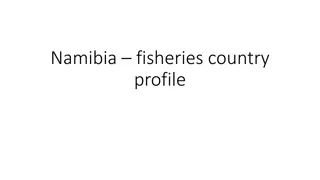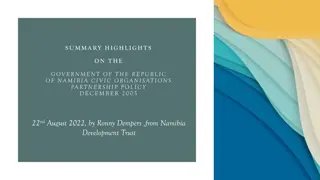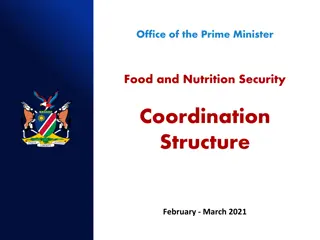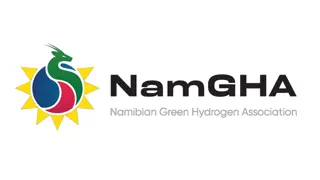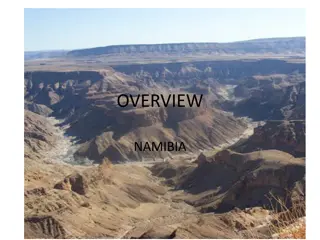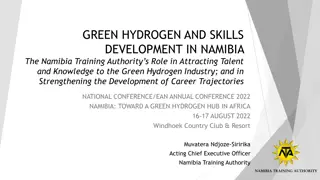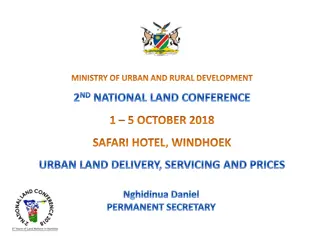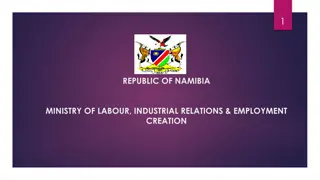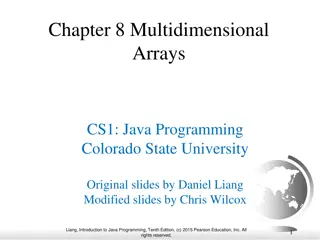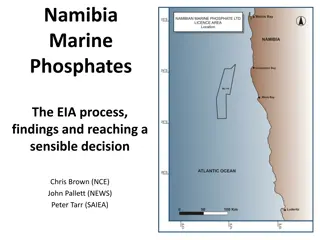Multi-Dimensional Poverty Analysis in Namibia
Namibia conducted a Multi-Dimensional Poverty Analysis presented at a high-level meeting in Seychelles in July 2019. The analysis covered various aspects such as population statistics, poverty rates, food insecurity, literacy rate, GDP, and more. It highlighted the methodology used, dimensions, indicators, and weighting metrics for measuring poverty, emphasizing the need to go beyond income-based metrics to capture the true experience of poverty in the country.
Download Presentation

Please find below an Image/Link to download the presentation.
The content on the website is provided AS IS for your information and personal use only. It may not be sold, licensed, or shared on other websites without obtaining consent from the author.If you encounter any issues during the download, it is possible that the publisher has removed the file from their server.
You are allowed to download the files provided on this website for personal or commercial use, subject to the condition that they are used lawfully. All files are the property of their respective owners.
The content on the website is provided AS IS for your information and personal use only. It may not be sold, licensed, or shared on other websites without obtaining consent from the author.
E N D
Presentation Transcript
NAMIBIA Multi-Dimensional Poverty Analysis SHARED AT MPPN HIGH-LEVEL MEETING MAHE, SEYCHELLES, 1-3 JULY 2019 BY: NAMIBIA STATISTICS AGENCY WEB SITE: www.nsa.org.na
PRESENTATION COVERAGE 1. NAMIBIA STATS AT A GLANCE 2. OVERVIEW & METHODOLOGY 3. DIMESIONS, INDICATORS ANS WEITHING METRICS 4. DATA SOURCES 5. CHALLENGES AND WAY FORWARD
NAMIBIA STATS AT GLANCE 1. POP: 2.1MILLION ; POP DENSITY: 2.8 2. LITERACY RATE: 89% 3. AVERAGE HH SIZE:3.9 4. POOR POPULATION : 17.4% 5. SEVERY POOR POP: 10.7%
NAMIBIA STATS AT GLANCE 6. FOOD POOR POPULATION: 6.1% 7. GINI COEFFICIENT: 56% 8. URBAN POP: 43% & RURAL POP:57% 9. GDP AT CONSTANT 2010 PRICE: 108.9 BILLION OF N$ 10. GDP AT CURRENT PRICES: 192.1 BILLION OF N$
OVERVIEW & METHODOLOGY Namibia used income or consumption measure of poverty since its first NHIES in 1993/1994 to last NHIES in 2015/2016 Income is One-dimensional and not possible to fully capture the experience of poverty hence MPI approach 2018 Namibia commission a study with World bank support to pilot the MPI using Alkire-Foster (AF) methodology Namibia, agrees to use Four Dimensions: Education, Health & Nutrition, Living standards, Economic activity, Different indicators per dimension has been identified with agreed deprivation cut off Methodology and pilot results was shared with national stakeholders
DIMENSIONS, INDICATORS AND WEITHING METRICS Dimension Indicator Deprivation Cut-offs Weight EducationYears of Below primary and not stated 0.25 Educational attainment schooling Diet diversity score based on: wheat, cereals, potatoes, rice, veg, fruits, dairy poultry, ,eat, fish, oils/fats Deprived if diet diversity has a score less than or equal to four Nutrition and Health 0.06 Diet diversity Suffer from any chronic illness(severe, mild, low), deprived if two levels of intensity are present 0.06 Chronic Illness Suffer from chronic illness
DIMENSIONS, INDICATORS AND WEITHING METRICS Dimension Indicator Deprivation Cut-offs Weight Sanitation Type of toilet Deprived if no facility/ open pit/bucket If unprotected and related sources like rainwater, stream, stagnant water, etc. If made of sand, clay or others If using coal, dung, charcoal, firewood, paraffin, etc. If no connection If not possessing any three of the mentioned 0.06 Water Source of drinking water 0.06 Floor Main flooring material 0.06 Standard of living Cooking fuel Cooking fuel used 0.06 Electricity Access to electricity Owns car, radios, television, refrigerator, bicycle, internet Distance in kms to bank, Household income from interest on savings/investments 0.06 Assets 0.06 Total round trip walk is less than or equal to 45 mins, No Financial inclusion 0.13 Economic activity Deprived if in-kind, subsistence farming, others Employment Main source of income 0.13
DATA SOURCES Country Namibia Namibia Household Income and Expenditure Survey (2015/16) Financial Inclusion Survey (2018) Dataset Source 2015-16 2018 41,581 individuals, 10,090 households Year Population Sample Etc...
CHALLENGES & WAY FORWARD Lack of technical skills in developing MPI Missing values for some key indicators Establish National Steering committee that will spearhead MPI collaboration Technical support to train NSA staff and National partners



